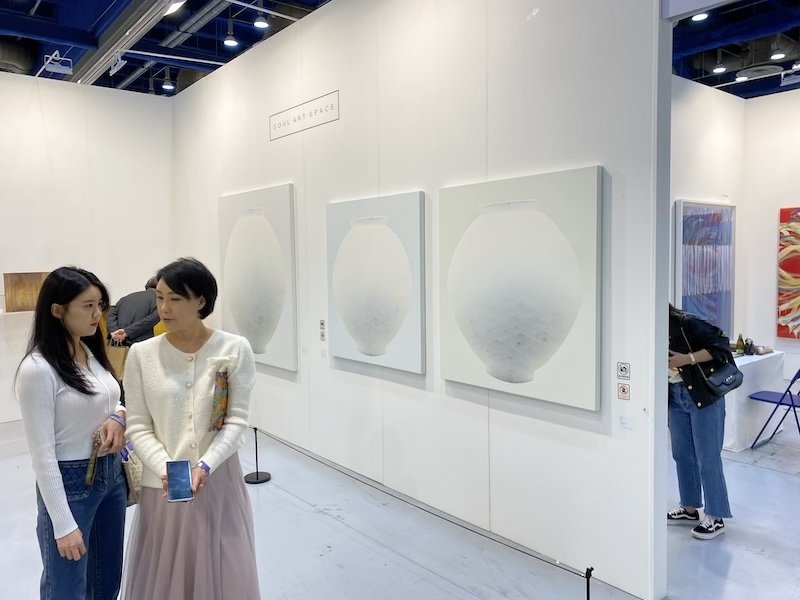Korean artists: No more Moon Jars, please!
One of the most beautiful expressions of the Korean spirit is the so-called moon jar. The name is self-explanatory: the round white porcelain pot looks like a full moon. They were made by throwing two separate bowls on the potter’s wheel and joining them in the middle. No moon jar is precisely round, which is what gives them their special charm. Nor are they ever perfectly smooth and white.
Actually, the name is not historical, and was first used in the early twentieth century. In the records of the Joseon period, these jars were called ‘wonho’, meaning ‘round jar’. They first appeared in the late seventeenth century and became very popular in the royal court in the first half of the eighteenth century. But by the end of the century, they’d gone out of fashion and disappeared. No one knows just what the jars were used for. Some have inscriptions referring to the royal kitchen, and have residue of vegetable oil inside. So, they were probably used to store liquids or food. In other words, they weren’t meant to be sat up on a plinth to be admired for purely aesthetic value. Like all pottery, a moon jar had a functional purpose as well as an aesthetic one.
As British person, I was already vaguely familiar with the moon jar before first coming to Korea because there is a fabulous example in the British Museum. This is the one illustrated at the start of this post.
The story of how the jar ended up in central London is interesting. The great English potter Bernard Leach (1887 – 1979) purchased the jar on a visit to Seoul, then called Keijo, capital of the Japanese colony, Chōson. Leach had come to Seoul from Japan, where he spent a good deal of time, with his Japanese friend, the art historian Yanagi Muneyoshi (1889 - 1961). Muneyoshi was a great exponent of Korean ceramic ware. In his book Joseon and its Art, he wrote: “Regardless of the East and the West, if the times are advanced, techniques become more and more complex. We can find an interesting exception from Joseon’s ceramic art, though. Its beauty is in its return to simplicity.... Isn’t trust of nature the astonishing distinction of Joseon’s art?” Leach said that the jar was like ‘carrying a piece of happiness’. He asked the potter Lucie Rie (1902 – 95) to care of it for the duration of the war, and Leach decided it should stay with her after the war ended. After Rie’s death, it was bequeathed to Leach’s widow, and the British Museum acquired it from the Leach estate in 1999. In other words, it hasn’t been there very long when I first saw it, some time in the early 2000s.
Many have described the moon jar as the quintessence of traditional ‘koreanness.’ They are understood to exemplify the Neo-Confucian ideals of purity and integrity. Kim Whanki (1913 – 1974), the first internationally fêted modern artist from Korea, loved and collected moon jars. He also painted them. Like this one, ‘Moon Jar’ (1958), oil on canvas, 61.4x38.3cm:
***
The moon jar is also painted by many contemporary Korean artists, as I saw when I visited this year’s Galleries Art Fair at COEX in Seoul. I was there primarily because I was one of the exhibiting artists, showing work with the Seoul-based Gallery JJ. Here I am with my paintings:
And here are a couple of close-ups. They are examples of my Book-Paintings, which look at first like monochromes but are actually based on the covers or title pages of books from the twentieth century:
This one is based on a French book about Kim Whanki from 1984.. Acrylic on canvas, 73x60.5cm.
This one is based on a translation of a famous book by Carl Jung, ‘Modern Man in Search of a Soul’, published in 1933. Acrylic on canvas, 45x38cm.
And here is a photo tour of some of the Fair’s rich crop of moon jar paintings:
It’s inevitable that a cultural icon quickly becomes a cliché. In my humble opinion, it’s high time to propose a ban on moon jar paintings! What do you think?
Image Credits:
The moon jar : https://www.britishmuseum.org/collection/object/A_1999-0302-1
The Kim Whanki painting: https://www.mutualart.com/Artwork/Moon-and-Jar/4DF815ED795D95E4










